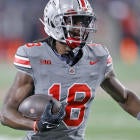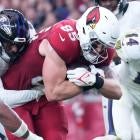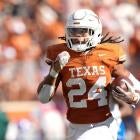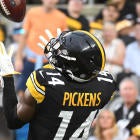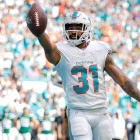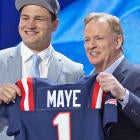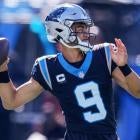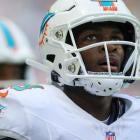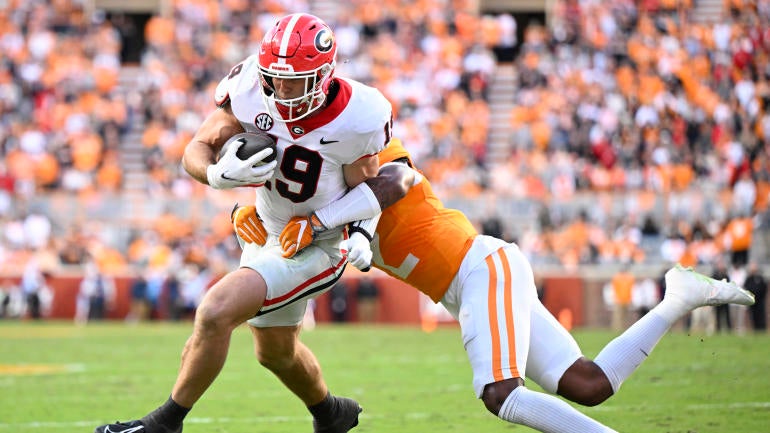
The Las Vegas Raiders selected tight end Brock Bowers with the No. 13 overall pick in the 2024 NFL Draft. Here's what you need to know about his Fantasy stock in both season-long and Dynasty formats.
Bowers' Fantasy fit with the Raiders
Bowers' after-catch potential and mismatch advantages combined with who he already is as a short-yardage target will bring a unique dimension to the Raiders offense. The obvious issues with Bowers in 2024: He'll share the field with Davante Adams, and the Raiders QB situation is among the worst in the league after they were shut out from any of the top-six passers in the draft. As long as Adams is in Vegas, Bowers won't be the top target-getter too often, and even after Adams leaves Vegas there will probably be someone else brought in to lead the way downfield for the Raiders. It likely ties Bowers to being second in targets annually, including this season when he'll pick up short throws from Gardner Minshew, who had the 21st-ranked Average Depth of Target last year and an 11% deep throw rate (Aidan O'Connell was similar to Minshew). Bowers will be a trendy TE pick, but he shouldn't be taken before Round 7.
Dynasty Outlook
Bowers is the supposed next big thing at tight end, so a lot of Dynasty managers will not resist him. He's got the speed to out-run linebackers, the size to out-maneuver safeties and the power to blast through almost anyone. It's scary to think that as awesome as he was at Georgia, there's still room for him to improve and become a more complete target. It's also scary to think about how long he'll play without a quality quarterback in Las Vegas, or if he'll ever ascend to his potential and get targets like George Kittle or even Travis Kelce got in their best days. Because it's not clear just how dominant he'll be in Vegas, expect the top three receivers from this class to get taken ahead of him in all rookie-only drafts. That puts him at a likely fourth-overall consensus on one-QB leagues and more like a sixth or seventh overall target in SuperFlex/two-QB.
Brock Bowers: What to know
Brock Allen Bowers' athletic traits aren't shocking at all when you consider his lineage. His mother, DeAnna, was an All-American softball player and later became a member of the Utah State athletic Hall of Fame. His father, Warren, was an All-Big West center on the Utah State football team. Together they raised Bowers and his older sister Brianna (who played softball at Sacramento State) in Napa, California. Bowers played football, baseball, basketball and soccer as a child but embraced basketball and football because they were faster-paced. But once football coaches saw him play 7-on-7 football as a six-foot-tall eighth grader with unreal coordination, he got locked into football.
He was Napa High School's junior varsity quarterback as a freshman, running the triple-option offense. The following year he moved to varsity as a wide receiver/tight end hybrid. He'd play in more 7-on-7 games and would dominate double- and triple-team coverage. College scholarship offers started coming in after that and after a stunning showing at a Nike Combine event. The recruiting included Georgia tight ends coach Todd Hartley going so far as to visit Bowers' mother at her workplace. The Bulldogs offered Bowers a chance to play right away, which is what he did after his successful junior season (39 catches for 1,098 yards and 14 touchdowns with another three rushing scores!). Once Covid-19 canceled his senior season, Bowers, who earned a four-star composite rating by 247Sports, enrolled early at Georgia and through a series of events became the team's top tight end as a true freshman in 2021 -- when he scored 13 touchdowns, a school record.
Age as of Week 1: 22 | Height: 6-foot-3 1/8 | Weight: 243 | Hand: 9 3/4 | Arm: 32 3/4 | Wing: 78 1/4
Comparable body-type to: Dustin Keller
We're breaking down everything you need to know about Bowers from a Fantasy manager perspective, including a scouting report, key stats and an NFL comparison.
Scouting report
Strengths
- Bowers has a thick body with solid height for the tight end position. He will be a matchup problem in the pros. His height is just below some of the well-known tight ends like Travis Kelce (nearly 6-foot-5), Mark Andrews (over 6-foot-5) or George Kittle (nearly 6-foot-4); his weight could improve to be at the level of these guys. Assume that will happen. Has nearly 10-inch hands, and it showed in his game both as a receiver and as a blocker.
- Lined up everywhere -- and I mean everywhere. In-line tight end, in the slot, out wide, in the backfield, even as an option quarterback (which he had experience in). Took direct snaps and handoffs on occasion and was used as a short-yardage weapon at Georgia. Could be used as such near the goal line.
- Had good footwork, especially given his height and girth. Bowers utilized good short-area quickness and agility when changing directions to help get open on short slants, digs and outs. Ran his routes nicely once he was parallel to the line of scrimmage to help him wall off defenders and create space for his quarterback to throw to.
- You'll find some games where Bowers' speed wasn't great last year, but those came after an ankle injury that lingered. When healthy, Bowers had very good speed for a tight end. During the Auburn game, the CBS broadcast claimed he ran a 4.5 in the 40, which happened to be the same time he ran as a high schooler at a Nike camp. Bowers won't be impossible for linebackers to keep up with, but he will have some wins based on his speed, probably more so after the catch than before.
Auburn has kept this one close. But this huge run-after catch for Georgia star Brock Bowers for the TD puts the Bulldogs on top with 2:52 to go in the fourth quarter. pic.twitter.com/iFC7NI71W2
— The Comeback (@thecomeback) September 30, 2023
- Was utilized primarily as a short-area target for Georgia; 99 of his career 175 receptions (56.6%) came on throws that traveled 5 Air Yards or fewer and many were behind the line of scrimmage (think screen passes). Bowers should be an instant addition in the short-area passing game for any team.
- Won consistently on short timed routes (digs, outs, slants). mostly by using his quick feet and body to either get a step or shield away the catch from a defender.
- Was great as a zone coverage beater and should be able to prove quickly that he knows where to find gaps in coverage to become a quality target for his quarterback.
- Bowers did a good job routinely adjusting to off-target throws, using his long arms and grabby hands to reel in imperfect passes. Mixed in occasional one-handed grabs to dazzle along the way.
After a slower start by his standards, Georgia has begun to feed TE Brock Bowers, and he’s showing why he’s one of the best TE prospects we’ve seen in years.
— Seven Rounds in Heaven (@7RoundsInHeaven) September 30, 2023
Back to back plays, Bowers bringing in terrific one handed grabs he makes look easy.
(second came back due to penalty) pic.twitter.com/QTDJ3S4B30
- As you might expect, Bowers didn't go down easily once he had the ball. He was a physical player with potential to be even more of a monster if he adds muscle to his frame. There were occasions where he made a quick catch before absorbing contact, holding on to the ball or even staying on his feet for extra yards. You'll want to read up on what he did after the catch in the advanced stats below.
Lol Bowers doesn't have to hurdle, he breaks tackles like a man.pic.twitter.com/d244FBRMqt
— ℍ𝕒𝕞𝕚𝕝𝕥𝕠𝕟⚡️ (@HamDawg115) October 22, 2023
- Was a dynamic deep threat earlier in his career, catching 62.8% of his targets of 15-plus Air Yards for a gaudy 30.7 yards per catch including 10.7 Yards After Catch per reception. He had three plays of 70-plus yards (most of the yards on those came after the catch) and another five of 30-plus yards (most of those yards came before the catch). These numbers dropped in 2023 -- more on that in the advanced stats below.
- Was also used cleverly as a rusher over his career, scoring five times on the ground including one from 75 yards against Kent State in 2022.
- Was used often as a blocker for Georgia. He always gave a good effort and was mostly effective.
- Athletic family: Both parents starred in sports at Utah State (his dad played center for the football team); sister played softball for Sacramento State.
Concerns
- Had just a solid get-off from the snap and didn't explode into his routes. He did better when he was in motion and had a running start.
- It's a little troubling that in three years Bowers never grew his route depth considerably. In fact, it got shorter as he got older -- his 2023 Average Depth of Target was 6.55 whereas he was at 9.02 in 2022 and 8.8 in 2021. And as mentioned above, nearly 57% of his career receptions came on throws of five or fewer Air Yards ... and 30.9% (54 of 175) were thrown 11-plus Air Yards. Coaches will obviously deploy Bowers in a number of ways, but they have some work to do.
- Bowers also didn't get a ton of 50-50 balls thrown his way, and the ones he did see weren't caught often. By my count he had only five such jump balls in 2023, catching none. Additionally, Bowers had four jump balls in the end zone in 2022 and came away with one for a touchdown. There's work to be done here and clearly room for improvement, but it's not like defenders will routinely be at a disadvantage in these spots.
- Had the ball knocked out a handful of times last year and needs to do more to protect the ball all the time. This includes some 50-50 targets he leaped for as well.
Georgia TE Brock Bowers put on a show against Auburn and his numbers could’ve been even better if Jaylin Simpson doesn’t make this play 👇.
— Jim Nagy (@JimNagy_SB) October 3, 2023
Checkout how cleanly & confidently @jaylinsimp breaks on this ball.
Some guys just have that ball-hawking knack and Simpson’s got it.… pic.twitter.com/A9EfV4GNl5
- Vision once he caught the ball wasn't a plus as he frequently ran to contact and didn't always follow his blocks. It almost felt like he ran more on instinct, costing him some extra yardage. He also didn't execute great body control as his momentum would sometimes take him into a defender or out of bounds.
- Efforted as a blocker but there were times he'd either get shed by a defender quickly or over-pursue to a spot and run past the guy he was supposed to block. He can get better here.
- Does have an extensive reported list of mostly minor injuries: Broke his arm trying to dunk as a child and had a cracked fibula while training in high school. At Georgia, he had labrum surgery and kept him from participating in spring practice before the 2022 season. He hurt his ankle against Vanderbilt in 2023, missed two games, came back for two games, then missed another before the SEC Championship game against Alabama. He sat out the bowl game against FSU because of the ankle, though he may not have wanted to play anyway as it was clear he was going to go pro.
Stats breakdown
| | G | Tar | Rec | ReYds | Avg | Total TD |
| 2023 | 10 | 71 | 56 | 714 | 12.8 | 7 |
| 2023 v Top-25 | 4 | 29 | 22 | 279 | 12.7 | 3 |
| Career | 40 | 224 | 175 | 2538 | 14.5 | 31 |
Advanced stats to know
- Was top three among FBS tight ends in 2023 with at least 50 targets in receptions (56, 2nd), yards (714, 2nd), yards per game (71.4, 1st), yards per route run (2.68, 2nd), Yards After Catch per reception (8.7, 3rd) and avoided tackle rate (32.1%, 3rd). Was sixth in catch rate (78.9%), 11th in yards per catch (12.8), fourth in touchdowns (six), 12th in end-zone targets (five) and ninth in explosive play rate (22.5%).
- Bowers' ADOT was 6.55, 28th among those qualifying tight ends in 2023. In 2022 his ADOT was 9.02, fourth-best among tight ends. In 2021 his ADOT was 8.8, 14th among tight ends.
- On throws of five or fewer Air Yards over his career, Bowers caught 99 of his 175 receptions (56.6%). He gained 821 yards on those throws (32.3% of his total career yards) and scored nine touchdowns (34.6% of his total career touchdowns). That's less than ideal.
- Specifically on screen throws over his career, Bowers caught 40 of his 175 receptions (22.9%). He gained 318 yards on those plays (12.5% of his total career yards) with three touchdowns (11.5% of his total career scores). That's a little better, but not ideal.
- On throws of 6 to 14 Air Yards over his career, Bowers had 40 receptions for a nice 633 yards and seven touchdowns. That makes up 22.9% of his receptions, 24.9% of his yardage and 26.9% of his touchdowns.
- On throws of 15-plus Air Yards over his career, Bowers had 36 receptions for a jaw-on-the-floor 1,087 yards and 10 touchdowns. That means on 20.6% of his career grabs he hauled in 42.8% of his career yardage and 38.5% of his career touchdowns. It's worth noting that these numbers are heavily weighted by his freshman and sophomore years, not by his junior year when he caught nine such passes for "only" 258 yards and two scores.
- Over his career, 1,487 of his 2,538 receiving yards came after the catch. That was 58.6% of his total career yardage. By comparison, Sam LaPorta had 47.6% of his yards come after the catch and Kyle Pitts had 36.1% of his come post-grab. For Bowers, this is pretty epic even if it was manufactured by all the short throws he got.
- In the red zone over his career Bowers caught 29 of 46 targets (63%) for 231 yards and 15 of his 26 touchdowns with two drops. That's pretty good, but it's worth pointing out that in 2023 he caught just half of his 16 targets in the red zone for 66 yards and three scores. Again, he was better here in the past.
- If you drill down inside the 10-yard line you'll feel better about Bowers' 2023 compared to prior years. In 2023 he caught 3 of 4 passes inside the 10 for three touchdowns. For his career, he caught 14 of 19 targets for 12 of his 26 career touchdowns. No doubt he should be a low red-zone weapon for his next team.
- Bowers had 19 career rush attempts for 193 yards (10.2 yards per carry) and five touchdowns. Four of the touchdowns came in the red zone, none from the 1-yard line. In fact, Bowers never had a carry on a down with one yard to go -- but had four rushes with two yards to go, converting three for a first down and getting penalized on one for a personal foul (he got the yardage but the play was called back).
NFL comparison
With a build like George Kittle and an aggressive streak as a blocker and receiver like Kittle, it's easy to make the comparison even if Bowers has a lot of work to do to be as effective as Kittle on mid-range throws. But the gist is that if he get coached as well as Kittle did he can become as good -- and perhaps break out sooner than Kittle did.














